|
|

Handbook on Viewing Buddhist Statues
A totally wonderful
book. The image at
the top of this page
was scanned from
this book; Japanese
language only; 192
pages; 80 or so
color photos. By
author Ishii Ayako.
Click here to
buy book at Amazon
|
|
|
English
|
Japanese
|
Chinese
|
Sanskrit / Pali
|
Korean
|
Tibetan
|
|
Space Repository,
Boundless Wisdom,
Deity of Memory,
Patron of Artisans
|
Kokūzō 虚空蔵,
Kokuzo 虚空蔵,
Kokūyō 虚空孕

|
Xūkōng Zàng Púsà, Zukongzang,
Hsü-kung tsang,
Xu Kong Zang

|
गगनगञ्ज
Ākāśagarbha, Akasagarbha, Akashagarbha, Khagarbha
|
허공장
Heogong jang,
Hŏkong chang
|
Nam kai nying po,
Namkhai Nyingpo,
Namkhai snying-po
|
|
 
Kokūzō Bosatsu 虚空蔵菩薩
Bodhisattva of Wisdom & Memory
Kokūzō is especially important to Japan’s Shingon sect of Esoteric Buddhism (Mikkyō 密教). Kokūzō symbolizes the "vast and boundless" Buddha wisdom that permeates the universe. In Japan, believers pray to Kokūzō to grant them wisdom on their quest toward enlightenment. They also pray to Kokūzō to improve their memory, technical skills, and artistic talents.
- Origin India.
- Kokūzō is often translated as Space Repository or Sky Repository (空 = Space, Sky; 蔵 = Repository), for Kokūzō’s wisdom and compassion are said to be as boundless as the sky; Kokūzō personifies infinitely vast wisdom and compassion.
- One who removes obstacles, one who helps people recognize & overcome their errors, one who encourages the practice of the Six Perfections, one who fulfills all wishes.
- Invoked in the Gumonjihō 求聞持法, an esoteric rite to improve one’s memory that involves reciting Kokūzō’s morning star mantra. Kūkai 空海 (774 - 835), the founder of Japan’s Shingon sect, practiced this rite prior to achieving enlightenment.
- Identified with the planet Venus (Myōjō 明星) and with Aruṇa (charioteer of the sun in Hindu lore). Aruṇa also represents dawn. By tradition, the founder of Japan’s Shingon sect -- Kūkai -- attained enlightenment in the early dawn when Kokūzō appeared as the morning star and pierced Kūkai’s mouth. <source Sacred Kōyasan>
- One of 13 Deities 十三仏 (Jūsanbutsu) of Japan’s Shingon Sect; in this role, Kokūzō presides over the memorial service held on the 32nd anniversary after one's death.
- In the Womb World Mandala (Jp. = Taizōkai 胎藏界, Skt. = Garbhadhātu), Kokūzō appears as the central deity in the Court of Space (Kokūzō-in 虚空蔵院) wearing a crown of five gems, with right hand holding a sword and left a lotus topped with a jewel. Kokūzō also appears in the Court of Shaka (Shakain 釈迦院) as Shaka’s right-hand attendant; in this role, Kokūzō graps a fly whisk in one hand and a lotus topped with a green gem in the other.
- In the Diamond World Mandala (Jp. = Kongōkai; Skt. = Vajradhatu), Kokūzō appears as Kongōhō 金剛宝菩薩 (Skt. = Vajraratna), one of the 16 Great Bodhisattva; Kokūzō is also counted among the 16 Deities of the Auspicious Aeon.
- Appears in five forms known as the Godai Kokūzō Bosatsu 五大虚空蔵菩薩 (Five Great Kokūzō); the five are manifestations of the Five Buddha (Gobutsu 五仏) and are invoked in the Godai Kokūzōhō 五大虚空蔵法, an esoteric rite for fulfilling wishes and averting misfortune.
- Appears as the central object of worship in the Kokūzō Bosatsu Mandara 虚空蔵菩薩曼荼羅.
- In Japan, Kokūzō is also worshipped as the patron of craftspeople and artisans.
- On Japan’s Honshu island, children who are 13 years of age still follow the custom of paying homage to Kokūzō in the hopes of becoming more intelligent.
- Guardian of People Born in the Zodiac Years of the Ox and the Tiger. Click here to find your patron deity.
English Translations for Kokūzō
- Womb of the Sky
- Treasure of Emptiness
- Bodhisattva of Space (Wisdom of Emptiness)
- Vast & Boundless Vessel of Buddha’s Wisdom
- Bodhisattva of All-Encompassing Wisdom.
- Space / Sky Repository (also Space / Sky Treasury)
- Guardian of the Treasury of All Wisdom & Achievement

Shingon Mantras for Kokūzō

oṃ vajra ratna oṃ trāḥ svāhā (transliteration)
Sanskrit version. Script courtesy visiblemantra.org.

on bazara aratannō on taraku sowaka
Japanese version of above Sanskrit mantra.
A shortened version of the mantra is:
on basara aratana kan on basara aratana un
おん ばさら あらたな かん おん ばさら あらたな うん.

Gumonjihō 求聞持法
Esoteric Rite to Improve One’s Memory
Morning Star Mantra, Kokūzō as the Morning Star
Kokūzō was introduced to Japan in the late Nara period (circa 790 AD) as part of an esoteric rite to improve one's memory, and even today Kokūzō is venerated as a deity who bestows intelligence on devotees. The esoteric rite, known as Gumonjihō or Gubunjihō 求聞持法 (Chn. = Qiúwén chífǎ), comes from a sutra known in Japan as Kokūzō Bosatsu nō man shogan saishō shin darani gumonji hō 虛空藏菩薩能滿諸願最勝心陀羅尼求聞持法 (Taishō Canon #1145). It was first translated into Chinese in 716 CE, and may be loosely translated as Kokuzo Bosatsu's power-filled, wish-fulfilling, supreme mind dharāṇi technique for seeking, hearing, and retention.
Kūkai 空海 (774–835), the patriarch of Japan’s Shingon sect, was taught to recite the Gumonji-hō mantra during his training as a teenager. Since the sutra promises devotees who earnestly recite the mantra that Kokūzō will appear to them as the morning star, the chant is also called the Morning Star mantra. Kūkai reportedly attained enlightenment in the early dawn at Cape Muroto (Shikoku island) while reciting the mantra, and as promised, Kokūzō appeared to him in the form of the morning star. Kūkai himself writes in the Sangō Shiiki 三教指帰 (Guide to the Three Teachings, 797 AD): “The valleys echoed, and the morning star made its appearance.”

namo ākāśagarbhaya oṃ ārya kamari mauli svāhā (transliteration)
Morning Star Mantra in Sanskrit. Script courtesy visiblemantra.org.

nōbō akyasha kyarabaya on arikya mari bori sowaka
Japanese Version of Morning Star Mantra.
Kōbō Daishi 弘法大師 (Kūkai’s posthumous title, lit. = Great Teacher Kōbō), said people who chant this mantra one million times will gain the ability to remember and understand any Buddhist text. The Gumonjihō sutra itself says: “If people recite the mantra of Kokūzō one million times, in accord with the teachings [in this sutra], they will achieve the ability to memorize the words and understand the real meaning of all scriptures [they study].” <source: A History of Japanese Religion>

  In Japan, sculptures of Kokūzō are generally found only among Shingon temples and some Tendai temples, where special esoteric rites are still performed (mostly in secret) to ensure good memory, the granting of wishes, and the bestowal of Kokūzō's "vast and boundless" blessings. In Japan, sculptures of Kokūzō are generally found only among Shingon temples and some Tendai temples, where special esoteric rites are still performed (mostly in secret) to ensure good memory, the granting of wishes, and the bestowal of Kokūzō's "vast and boundless" blessings.
Kokūzō can appear in many different forms. In sculpture, Kokūzō's role as bestower of wishes means that Kokūzō is shown frequently holding the wish-granting jewel. In another variant, Kokūzō holds a lotus stem surmounted with the sacred wish-giving gem. In another popular representation, Kokūzō holds a sword to symbolize wisdom cutting through ignorance. Kokūzō is sometimes portrayed with the "Fear Not" Mudra, a gesture that symbolizes the granting of protection to Buddhist followers. NOTE: Photo at right shows Kokūzō forming the Fear Not Mudra while holding a lotus spear surmounted by the wish-granting jewel. At other times, Kokūzō is depicted with a hand gesture known as the Wish-Granting Mudra (aka the Charity, Welcome, or Blessing mudra). This latter mudra is associated closely with the Historical Buddha, and represents the granting of wishes to those who welcome the teachings of Buddhism.
Kokūzō is no longer venerated widely in Asia or Japan, with the exception of Japan's Shingon Sect of Esoteric Buddhism, where Kokūzō serves as one of the Thirteen Deities of the Shingon School. As one of the thirteen, Kokūzō presides over the memorial service held on the 32nd anniversary after one's death. On the Japanese island of Honshu, children who are 13 years of age still follow the custom of paying homage to Kokūzō in the hopes of becoming more intelligent. In Japan's esoteric traditions, Kokūzō is also counted among the 16 Deities of the Auspicious Aeon, and as one of the 16 Great Bodhisattva.
Kokūzō Bodhisattva (lit. Space Repository) was originally paired with Jizō Bodhisattva (lit. Earth Repository), with the two representing the blessings of space and earth respectively. This pairing is now almost completely forgotten. Today Jizō is one of Japan's most popular deities among the common folk, and is worshipped both independently and as an important member of Amida Buddha's retinue. In contrast, Kokūzō is a relatively neglected deity whose devotees come largely from the Shingon tradition.
Kokūzō's central role in the esoteric rite to improve one's memory is described in the Gumonjihō (Jp.). Kokūzō is described in the Kokuzo Sutra (Jp. = Kokūzō Bosatsu Kyō) as one who removes obstacles, one who helps people recognize and overcome their errors, and one who encourages the practice of the Six Perfections (Sanskrit = Paramita). In addition to the central virtue of compassion, there are six perfections that a Bodhisattva must cultivate in order to attain Buddhahood.

Six Perfections, Jp. = Ropparamitsu 六波羅蜜
Sanskrit = Pāramitā (read “Haramitsu” in Japan). Chn. = Liù pōluómì, Jp. = Ropparamitsu. The six perfections (Skt. = Pāramitās) are a set of Mahayana practices that lead to enlightenment if pursued with an attitude of detachment (wisdom of emptiness) -- without selfish intent for personal gain. Each perfection has its opposite (labeled “O” in below list).
- Charity, Generosity (Skt. Dana-paramita); selfless and impartial generosity. O = Meanness.
- Morality, Discipline (Skt. Shila-paramita); observance of the ethical regimen. O = Wickedness.
- Forbearance, Patience (Skt. Kshanti-paramita); patient endurance of difficulties.O = Anger.
- Effort, Energy (Skt. Virya-paramita); zealous energy in perseverance. O = Sloth.
- Meditation (Skt. Dhyana-paramita); mindful absorption in meditation. O = Distracted Mind.
- Wisdom (Skt. Prajna-paramita); wisdom of transcendent insight. O = Ignorance.
Also written as:
1. Generosity (J. = danna 檀那)
2. Right Conduct (J = shira 尸羅)
3. Endurance (J = sebdai 羼提)
4. Endeavor (J = biriya 毘梨耶)
5. Meditation (J = zenna 禅那)
6. Wisdom (J = hannya 般若).
Four more perfections were added in later times:
- Right method (or means)
- Vows
- Manifestation of 10 powers
- True understanding of all dharmas (laws)

Five Great Kokūzō
Below text courtesy JAANUS. There is a pentad called the Five Great Kokūzō Bodhisattva (Godai Kokūzō Bosatsu 五大虚空蔵菩薩). The five are manifestations of the Five Buddha (Gobutsu 五仏) of Esoteric Buddhism and invoked in the Godai Kokūzōhō 五大虚空蔵法, an esoteric rite for fulfilling wishes and averting misfortune. The names and descriptions of these five vary, but in the YUGIKYŌ 瑜祇経 sutra they are called:
- Hokkai Kokūzō 法界虚空蔵
- Kongō Kokūzō 金剛虚空蔵
- Hōkō Kokūzō 宝光虚空蔵
- Renge Kokūzō 蓮華虚空蔵
- Gyōyō Kokūzō 業用虚空蔵
There is a set of five at Kanchiin 観智院 in Tōji Temple 東寺 (Kyoto) brought from Tang China in 847 by Eun 恵運 (798-869) where the figures are seated on a lion, elephant, horse, peacock and garuda (mythical bird) respectively. Another set of five images at Jingoji 神護寺 (Kyoto) are seated on lotus pedestals and date from the mid-9th century. This latter set is a designated national treasure.
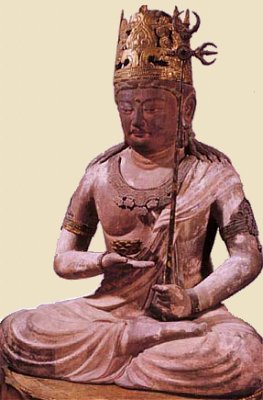
Godai Kokūzō Bodhisattva, Jingo-ji Temple 神護寺 (Kyoto)
Early Heian Period, 794-969 CE
Photo: SDSU School of Art, Design, and Art History
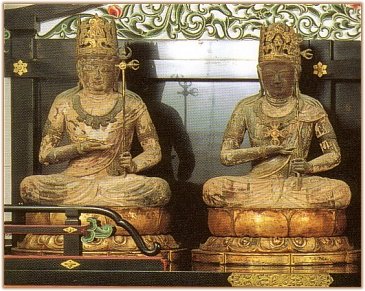
Kokūzō Bosatsu - 9th Century, Jingo-ji Temple 神護寺 (Kyoto)
Two of the Five Kokūzō (Godai Kokūzō)
Photo: SDSU School of Art, Design, and Art History
 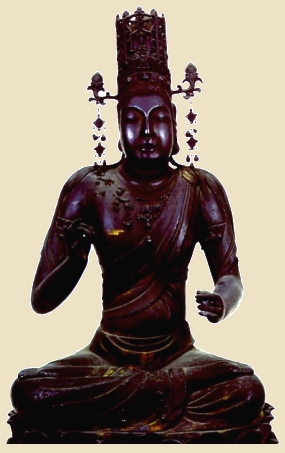
(L) Kongō Kokūzō 金剛虚空蔵, one of the Five Great Akasagarbha
Wood, Chinese Tang Dynasty, 9th century, Tōji Temple, Kyoto.
Others, like Ernest F. Fenollosa, date them from around 580 to 640 AD.
(R) Hokkai Kokūzō 法界虚空蔵, one of the Five Great Akasagarbha
Wood, Chinese Tang Dynasty, 9th century, Tōji Temple, Kyoto
Photos courtesy: National Research Institute for Cultural Properties (Tokyo)
ABOVE TWO PHOTOS: Tōji Temple 東寺 in Kyoto houses a wonderful hard-dark-wood-half-life-size set of five Kokūzō statues sitting on peacock, horse, and other animals. The statues were originally dated from around 580 to 640 AD, but subsequent research yielded a later date, sometime in the early 9th century AD. These rare wood sculptues were brought to Japan from China. Two of the five are shown above. The five statues are each seated on pedestals in the form of a lion, elephant, horse, peacock, and karura (bird man).

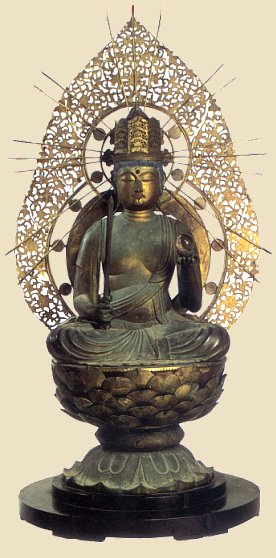
Kokuzo Bosatsu - Treasure of
Wood. H = 87.8 cm. Late Heian Period. Chūsonji Temple 中尊寺 (Iwate Prefecture).
Photo scanned from Japanese magazine 日本の美をめぐる, #35, Dec. 2002

Restored Painting - Unknown Artist and Date
Found on web at www.koku-j.com/english.html

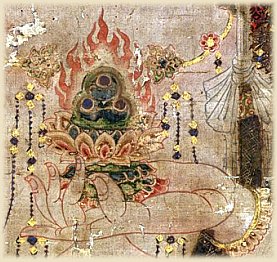
Closeup of wish-fulfilling jewel in below photo.
Painting in collection of Tokyo National Museum.
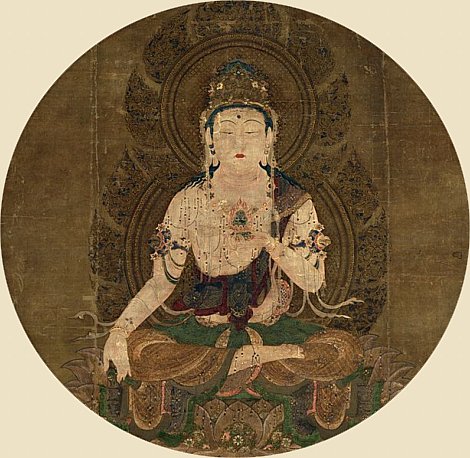
Painting in collection of Tokyo National Museum. Formerly owned by Mitsui Gomei Co.
H = 132.0, W = 84.4, Heian Period, 12th century, National Treasure.
Invoked in the Godai Kokūzōhō 五大虚空蔵法, an esoteric rite for fulfilling wishes & averting misfortune.
虚空蔵法(福徳法)の本尊

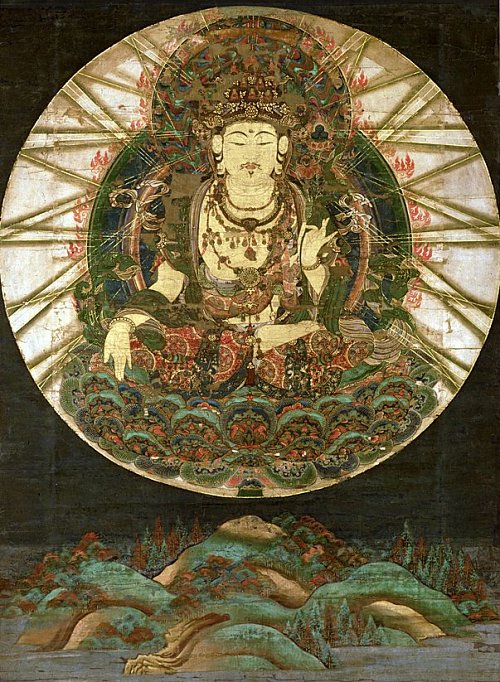
Painting in collection of Tokyo National Museum.
H = 108 cm, W = 60.8 cm. Kamakura era. Important Cultural Property.
Kokūzō is the central deity invoked in an esoteric rite to improve one’s memory. The rite is known
as the Gumonjihō 求聞持法 and was practiced early on by many notable monks, including
Dōji 道慈 (d. 744), Gonsō 勤操 (d. 827), Zengi 善議 (d. 812), and Kūkai 空海 (d. 835).
This painting was used as a visual aid during the Gumonjihō rite.

Learn More about Kokūzō
Resources
- See Bibliography for our complete list of resources on Japanese Buddhism, or visit any site page and scroll to the bottom for detailed resources on that specific deity or topic.
- JAANUS. Japanese Architecture & Art Net Users System. Compiled by the late Dr. Mary Neighbour Parent; covers both Buddhist and Shinto deities in great detail and contains over 8,000 entries.
- A Dictionary of Chinese Buddhist Terms. With Sanskrit & English Equivalents. Plus Sanskrit-Pali Index. By William Edward Soothill & Lewis Hodous. Hardcover, 530 pages. Published by Munshirm Manoharlal. Reprinted March 31, 2005. ISBN 8121511453.
- Butsuzō-zu-i 仏像図彙, the “Collected Illustrations of Buddhist Images.” First published in 1690, followed by an expanded version in 1793. One of Japan’s major studies of Buddhist iconography. Hundreds of pages and drawings, with deities classified into approximately 80 (eighty) categories. Modern-day reprints are available at this online store (J-site).
- Mandara Zuten 曼荼羅図典 (Japanese Edition). The Mandala Dictionary. 422 pages. First published in 1993. Publisher Daihorinkaku 大法輪閣. Language Japanese. ISBN-10: 480461102-9. Available at Amazon.
- Digital Dictionary of Chinese Buddhism (C. Muller; login "guest")
- Nanzan Institute for Religion and Culture. Numerous online scholarly papers and its semi-annual Japanese Journal of Religious Studies.
- A History of Japanese Religion. Edited by Kazuo Kasahara. Kosei Publishing Company, 2002. Translated by Paul McCarthy and Gaynor Sekimori. 648 pages. Sixteen distinguished experts on Japanese religion approach the topic from modern perspectives. Topics range from prehistoric times up until the early postwar years. Click here to read review of book by scholar Paul L. Swanson.
- Visser, M. W. de. The Bodhisattva Akasagarbha (Kokuzo) in China and Japan, Amsterdam: The Royal Dutch Academy of Sciences, 1931.

|
|